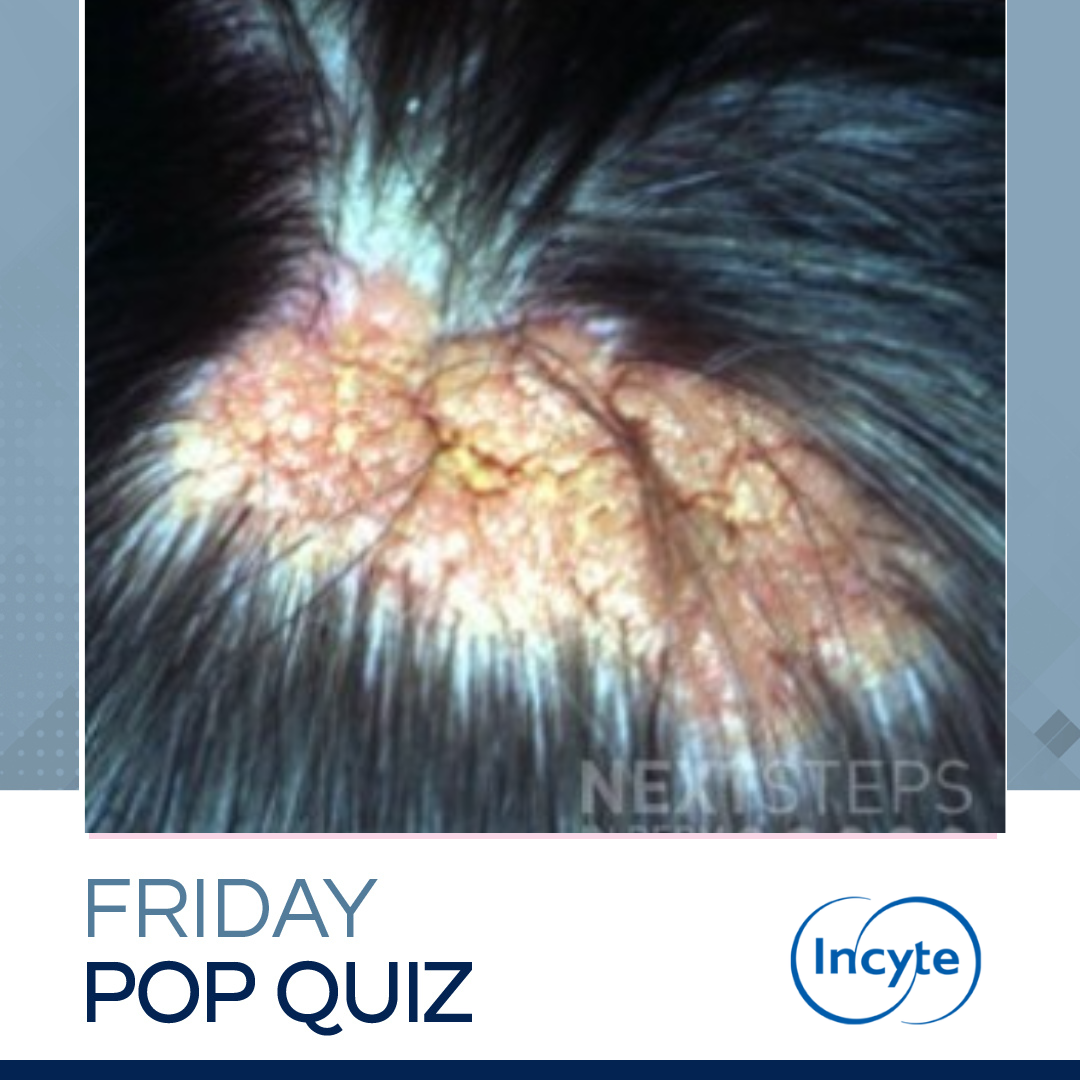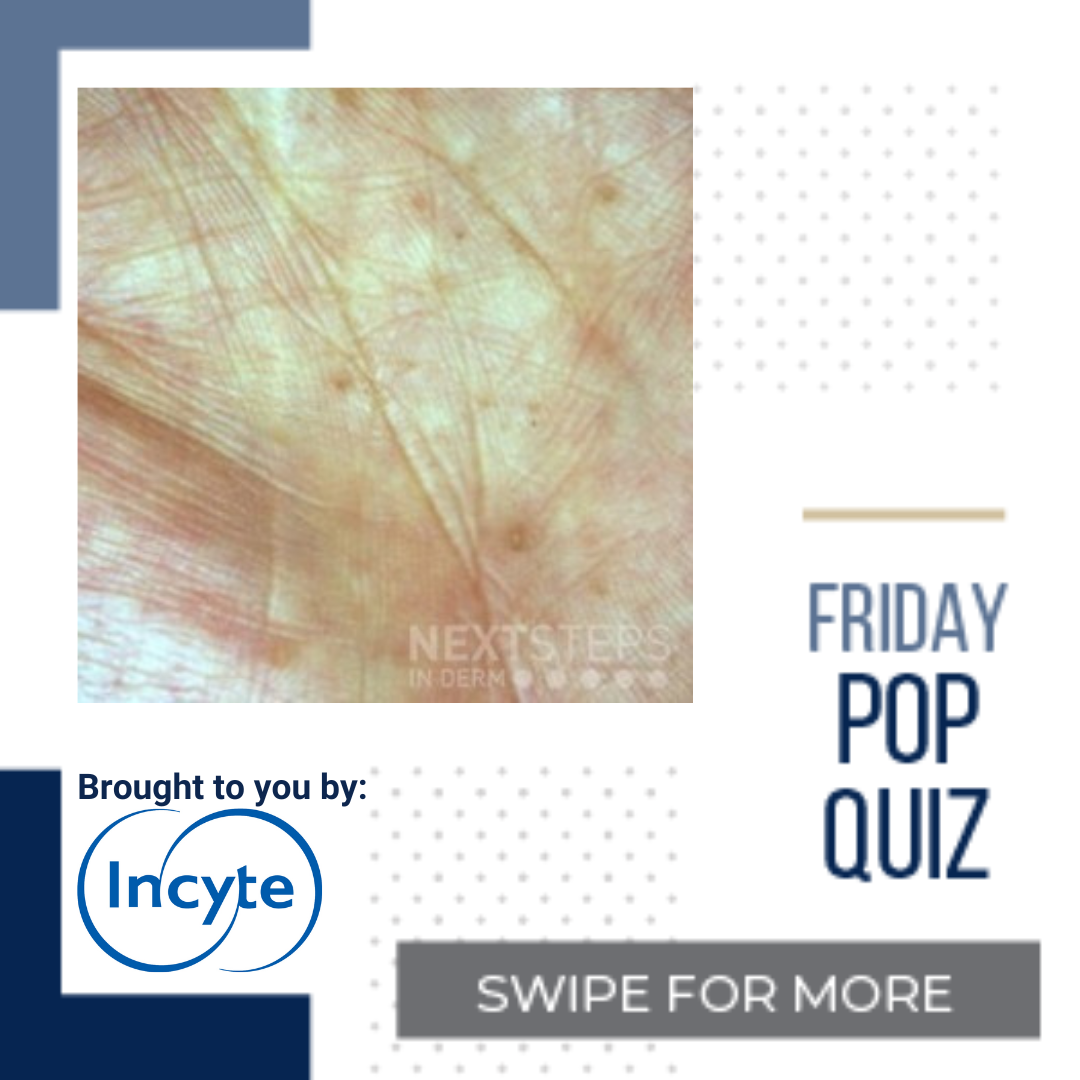Lesions – Friday Pop Quiz 8/18/2023
 Which of the following lesions is most likely to appear in the shown lesion?
A. Basal cell carcinoma
B. Eccrine poroma
C. Prurigo nodularis
D. Squamous cell carcinoma
E. Trichoblastoma
To find out the correct answer and read the explanation, click here.
Brought to you by our brand partner
…
Which of the following lesions is most likely to appear in the shown lesion?
A. Basal cell carcinoma
B. Eccrine poroma
C. Prurigo nodularis
D. Squamous cell carcinoma
E. Trichoblastoma
To find out the correct answer and read the explanation, click here.
Brought to you by our brand partner
…
 Which of the following lesions is most likely to appear in the shown lesion?
A. Basal cell carcinoma
B. Eccrine poroma
C. Prurigo nodularis
D. Squamous cell carcinoma
E. Trichoblastoma
To find out the correct answer and read the explanation, click here.
Brought to you by our brand partner
…
Which of the following lesions is most likely to appear in the shown lesion?
A. Basal cell carcinoma
B. Eccrine poroma
C. Prurigo nodularis
D. Squamous cell carcinoma
E. Trichoblastoma
To find out the correct answer and read the explanation, click here.
Brought to you by our brand partner
… 

 A 6-year-old child with a history of medulloblastoma presents for evaluation of lesions on his hands, as shown. He was previously seen for a basal cell carcinoma of the left distal forearm, which was excised. Which of the following is the most appropriate screening recommendation in this patient?
A. Abdominal ultrasound
B. Bone density scan
C. Genetic counseling
D. Hepato …
A 6-year-old child with a history of medulloblastoma presents for evaluation of lesions on his hands, as shown. He was previously seen for a basal cell carcinoma of the left distal forearm, which was excised. Which of the following is the most appropriate screening recommendation in this patient?
A. Abdominal ultrasound
B. Bone density scan
C. Genetic counseling
D. Hepato …  The May issue of the Journal of Drugs in Dermatology (JDD) focuses on skin cancer and includes the perfect blend of original articles and case reports. Topics include actinic keratosis versus squamous cell carcinoma, the utility of gene expression profiling in skin cancer, the prevalence of sunscreen use, and many more. Check out this month’s issue highlights straight from the JDD Editor’s …
The May issue of the Journal of Drugs in Dermatology (JDD) focuses on skin cancer and includes the perfect blend of original articles and case reports. Topics include actinic keratosis versus squamous cell carcinoma, the utility of gene expression profiling in skin cancer, the prevalence of sunscreen use, and many more. Check out this month’s issue highlights straight from the JDD Editor’s …  The May 2022 issue of the Journal of Drugs in Dermatology (JDD) focuses on skin cancer and features other topics such as fungal infections, updates on new topical advances, and Mohs micrographic surgery. We share this month’s issue highlights straight from the JDD Editor’s desk:
Insights in Skin of Color Patients With Atopic Dermatitis and the Role of Skincare in Improving Outcomes concludes …
The May 2022 issue of the Journal of Drugs in Dermatology (JDD) focuses on skin cancer and features other topics such as fungal infections, updates on new topical advances, and Mohs micrographic surgery. We share this month’s issue highlights straight from the JDD Editor’s desk:
Insights in Skin of Color Patients With Atopic Dermatitis and the Role of Skincare in Improving Outcomes concludes …  Suncare is important for every skin tone.
The risk of sunburn and skin cancer correlate with skin type – not ethnicity.1
Ethnicity does not confer skin type.
Our population is changing rapidly, and within the next few decades minority populations will become the majority.1,2
African Americans, Asians, Hispanics, Middle Easterners, Asian Pacific Islanders, Native Americans, or individuals …
Suncare is important for every skin tone.
The risk of sunburn and skin cancer correlate with skin type – not ethnicity.1
Ethnicity does not confer skin type.
Our population is changing rapidly, and within the next few decades minority populations will become the majority.1,2
African Americans, Asians, Hispanics, Middle Easterners, Asian Pacific Islanders, Native Americans, or individuals …